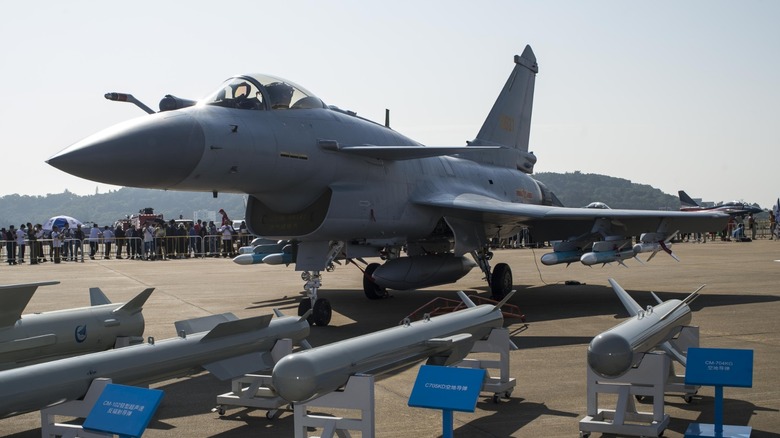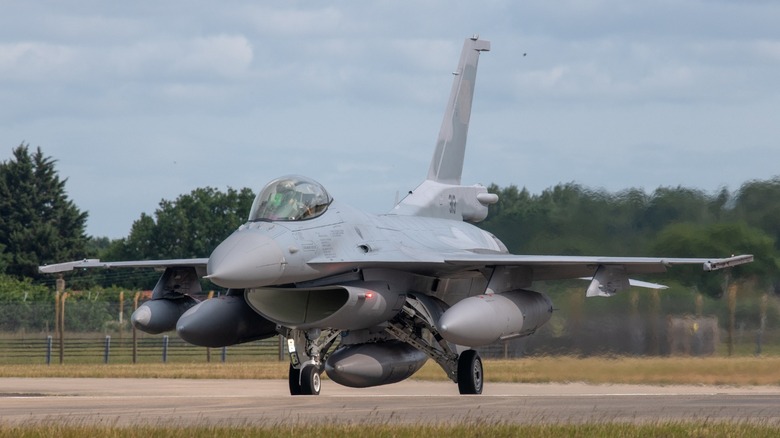The J-10 Fighter Is China's Answer To The F-16 – Here's How The Two Jets Stack Up
China is building up its military might, including making its own jets. Although it had previously relied on imports or licensed-built versions of Soviet or Russian jets, it eventually produced its own modern, homegrown aircraft. The J-10 Vigorous Dragon is one of the most advanced Chinese fighter jets known to exist today. Development of this single-engine multi-role fighter jet started in the 1980s and entered service with the People's Liberation Army Air Force (PLAAF) in 2004 as the J-10A.
It didn't stop at the first version, though, with the upgraded J-10B entering service in 2008 with a redesigned intake, improved sensors, and an upgraded cockpit and avionics. In 2015, the third iteration of this jet, the J-10C, took to the skies, featuring a more powerful active electronically scanned array (AESA) radar, datalink and satellite communications, and a new China-made WS-10 engine (replacing the Russian-made AL-31F engine).
One of the plane's striking features is its delta wing configuration with canards. This allows the jet to be nimbler than typical designs, even at low speeds, while using a quadruple-redundant fly-by-wire system, helping ensure that the pilot remains in control even during tight maneuvers. The J-10C, when paired with the latest WS-10C engine, is expected to produce 27,500 lbf of thrust, allowing it to hit a top speed of Mach 2.2. Additionally, it features 11 external hardpoints for mounting external fuel tanks, bombs, and missiles, with a maximum payload of 12,300 pounds.
More importantly, the J-10C is a relatively affordable jet, at just US$40 to $50 million. This is one of the reasons why some countries buy Chinese fighter jets, with Pakistan operating more than 25 Vigorous Dragon airframes. Other nations, including Bangladesh and Indonesia, have also expressed interest in it.
How the F-16 compares to the J-10C
The US also has a single-engine multi-role fighter in the F-16 Fighting Falcon. It's a rather old design, having first flown in 1976. Despite that, Lockheed Martin continued developing it, with the latest version, the F-16V, launching in 2012. It's one of the most popular fighter jets in the world, with over 3,100 in service with across the globe.
F-16 operators have two engine options: the Pratt & Whitney F100-PW-229, which delivers 29,100 lbf of thrust, and the GE F110-GE-129, with a slightly higher 29,500 lbf of output. But no matter which power plant you choose, the F-16 still has a top speed of Mach 2. It has a maximum payload of two 2,000-pound bombs, two AIM-9 missiles, two AIM-120 missiles, and two 2,400-pound external fuel tanks, and can also be equipped with both conventional and nuclear munitions. The base versions of this jet are quite cheap, with the price ranging between $25 to $30 million. But if you want to get the latest variant, the F-16's cost will balloon to $60 to $70 million each, making it far more expensive than the J-10C.
Some may argue that the F-16V is superior to the J-10C, especially given Lockheed Martin's extensive experience in building fighters. On the other hand, others may say that the J-10C is far newer, with the Chinese implementing lessons its engineers have learned over the years. But while technical prowess does play a role in any conflict, the training, military doctrine, and determination of pilots play a significant part in how these jets would perform in one-to-one combat.

